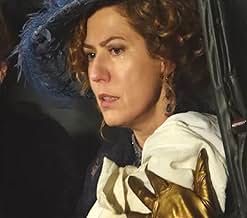Two women of different origins and social classes fight for their rights in the conservative society of Rio de Janeiro of the early 20th century.Two women of different origins and social classes fight for their rights in the conservative society of Rio de Janeiro of the early 20th century.Two women of different origins and social classes fight for their rights in the conservative society of Rio de Janeiro of the early 20th century.
- Awards
- 2 wins & 11 nominations
Browse episodes
Storyline
Did you know
- ConnectionsReferenced in vem_aí (2013)
- SoundtracksQuarto de Dormir
Written and performed by Marcelo Jeneci
Featured review
For those who enjoy a soap opera, Brazil is fertile ground, as the overwhelming majority of general TV channels in the country transmit, on average, four soap operas daily. Invariably, much of this material eventually goes around the world, being bought and broadcast in other countries. One of the most permeable markets for Brazilian teledramaturgy is, of course, my country, due to its cultural and linguistic proximity. I watched "Lado a Lado" at the premiere in Portugal in 2014.
This soap opera runs during the late nineteenth century. Brazil was now a republic and an emerging world power, but power was still in the hands of the old aristocratic families of the imperial period, while the poorest were marginalized. Thus, the deep friendship between the rich and privileged Laura and the modest Isabel would have everything to be improbable. They are known in the worst circumstances: Isabel has just been forgotten on the altar by her fiancé, Zé Maria, who was arrested before he could go to the church where they were to be married, and where Laura is preparing to contract a marriage, arranged by family conveniences, with the young journalist Edgar. This friendship will fiercely oppose Laura's mother, the powerful and manipulative Constancia Assunção, whose husband has skillfully made the transition from the imperial aristocracy to republican politics, retaining the title of Baron as well as the position of senator of the republican parliament. This soap opera thus speaks of the emergence of a black culture, and of the combat against prejudices, racial and gender.
Camila Pitanga and Marjorie Estiano give life to the two protagonists in a very positive and beautiful way. Their friendship, although improbable, is visible and credible throughout the plot thanks to the good interpretation of the two actresses. Also very good was the performance of Lázaro Ramos and Thiago Fragoso, in the role of the two male protagonists. Patricia Pillar was a compelling and strong villain. Still worthy of a positive highlight are Maria Padilha, Caio Blat, Cássio Gabus Mendes and Werner Schünemann.
This soap opera runs during the late nineteenth century. Brazil was now a republic and an emerging world power, but power was still in the hands of the old aristocratic families of the imperial period, while the poorest were marginalized. Thus, the deep friendship between the rich and privileged Laura and the modest Isabel would have everything to be improbable. They are known in the worst circumstances: Isabel has just been forgotten on the altar by her fiancé, Zé Maria, who was arrested before he could go to the church where they were to be married, and where Laura is preparing to contract a marriage, arranged by family conveniences, with the young journalist Edgar. This friendship will fiercely oppose Laura's mother, the powerful and manipulative Constancia Assunção, whose husband has skillfully made the transition from the imperial aristocracy to republican politics, retaining the title of Baron as well as the position of senator of the republican parliament. This soap opera thus speaks of the emergence of a black culture, and of the combat against prejudices, racial and gender.
Camila Pitanga and Marjorie Estiano give life to the two protagonists in a very positive and beautiful way. Their friendship, although improbable, is visible and credible throughout the plot thanks to the good interpretation of the two actresses. Also very good was the performance of Lázaro Ramos and Thiago Fragoso, in the role of the two male protagonists. Patricia Pillar was a compelling and strong villain. Still worthy of a positive highlight are Maria Padilha, Caio Blat, Cássio Gabus Mendes and Werner Schünemann.
- filipemanuelneto
- Dec 8, 2017
- Permalink
Details
- Release date
- Country of origin
- Official site
- Language
- Also known as
- Lado a lado
- Production company
- See more company credits at IMDbPro
- Color
Contribute to this page
Suggest an edit or add missing content
































